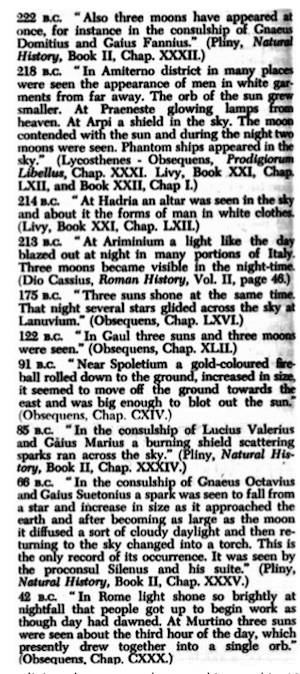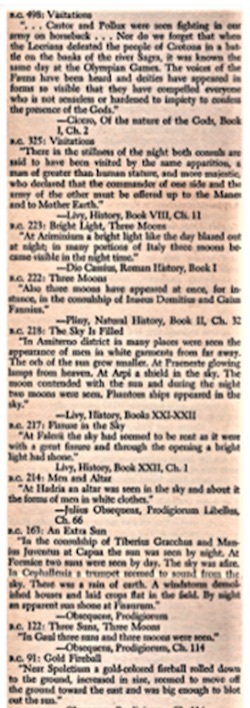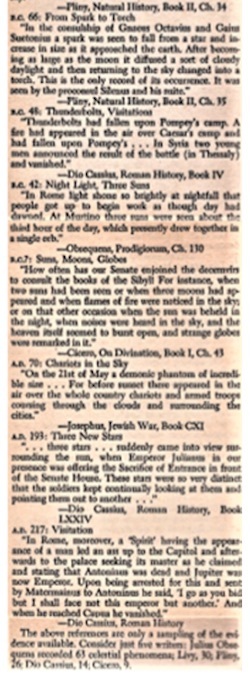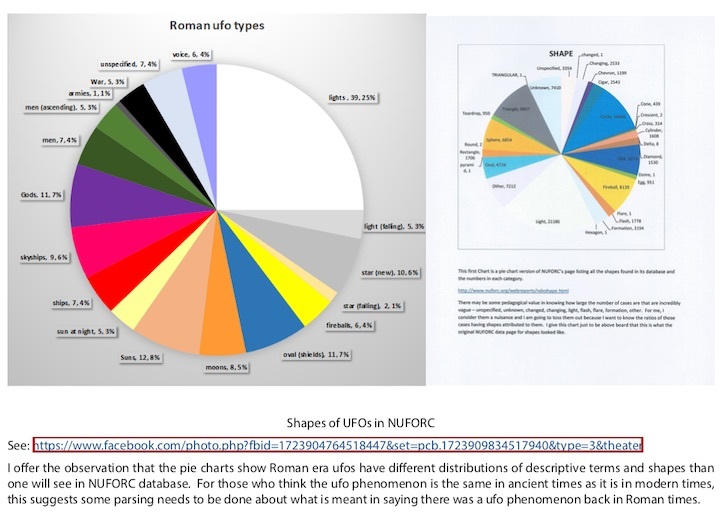
...
Roman Ufos
by
Marty Kottmeyer
In 1963, W. Raymond Drake published in Flying Saucer Review an article titled “UFOs over Ancient Rome.” He was upfront about his method and intent: “I selected about 50 writers of antiquity and scrutinized their main works through a UFO lens.” He would study the Classics for records of extraterrestrial visitation. Most particularly he would focus on the classic historians. He tallied 63 records of celestial phenomena in Obsequens, 30 in Livy, 26 in Pliny, 14 in Dio Cassius, and 9 in Cicero. He gave a breakdown of the types which we have converted into an accompanying pie-chart for those who like pictoral presentations of such statistical niceties. Of more ultimate significance he gave a list of 10 quotes from classical history giving sightings that he averred would have been distinguished enough to appear in any Roman counterpart to Flying Saucer Review had it existed.“These celestial objects were seen and recorded two thousand years ago by people who had never heard of flying saucers. Can they be glibly explained away by the double-talk of UFO experts? If the UFOs of antiquity were real, so must those be today... We should sweep away the dust and dog- ma of centuries and study phenomena as they really happened. The classical sightings of the past confirm the UFOs of the present.” 1
Drake was not the first UFO writer to assert there were UFOs during the Roman era, but his effort began a grouping of historical UFOs adopted by others which were demonstrably influential. His list contained errors and idiosyncrasies that were repeated by others. They’ve been incorporated into dozens of UFO chronologies on the Web. His list mis-dates multiple items, mis-spells names and places, and has problematic translations.

►His first choice places in 222 B.C. a prodigy of three moons happening during the consulship of “Gnaeus Domitius and Gaius Fannius.” That consulship in fact happens in 122 B.C.
►Arpi is included in an entry dated 218 B.C. It actually happened in either 217 B.C. or 216 B.C. depending on if you prefer dating it via the solar eclipse visible from Italy on February 11, 216 B.C. in the same list of prodigies, or via the 217 B.C. consulship of Servi- lius mentioned a few lines earlier in the relevant text.
►Drake writes, “At Arpi a shield in the sky.” The correct translation is shields plural.►Drake places a prodigy of light at night at Ariminium in 213 B.C. It should have been
223 B.C.
►A prodigy in Praeneste is in the 218 B.C. entry and described by Drake as glowing lamps. It is more properly set in 217 B.C. or 216 B.C. and translated as a shower of red- hot stones
►The date of the Hadria prodigy of an altar in the sky is given as 214 B.C. by Drake. It was actually set in 213 B.C.
►At 175 B.C., Drake sets “Three suns shone at the same time. That night several stars glided across the sky at Lanuvium.” Before Obsequens, Pliny speaks of three suns at the same time during the consulship of Sp. Postumius and L. Mucius, [174 B.C.].
►Livy Book 42, also earlier, actually reads, “At Lanuvium the sight of a great fleet had been witnessed in the heavens.” The initial line in book 42 gives Lucius Postumius Albi- nus & Popillius Laenas as consuls bringing matters before the Senate, thus the proper setting was 173 B.C. Thus, too, the three suns and the heavenly fleet happen in different years.
►Drake’s entry for 122 B.C. reads, “In Gaul three suns and three moons were seen.” (Ob- sequens, Ch. 42) While Obsequens does indeed say that, he misses that Obsequens had misread Pliny who said there were only three moons, but they termed such prodigies “nocturnal suns.”
►For 85 B.C., Drake writes, “In the consulship of Lucius Valerius and Gaius Marius a burn- ing shield scattering sparks ran across the sky.”(Pliny, Natural History, Book II, Chap. XXX- IV) Chris Aubeck & Jacques Vallee in Wonders in the Sky can be credited for correctly
realizing these consuls served instead in 100 B.C.
►For 66 B.C., Drake writes, “In the consulship of Gnaeus Octavius and Gaius Suetonius...” The correct year was 76 B.C. when the consuls were Gnaeus Octavius and Gaius Scribonius Curio Burbulieus. There is no Suetonius.
►Drake speaks of a proconsul named Silenus. Translations of Pliny give you ‘Licinius Syllanus’ or ‘Si- lanus’ with an ‘a.’ Silenus is actually the name of a sea-god who arose from some drops of blood of Uranus and was notorious for usually being drunk, but having a gift of prophecy in that condition.
►In the 42 B.C. entry he writes of a place named Murtino. Mutinensi, the term seen in the Latin orig- inal, is a province in Italy. Modena is the modern name of the capital in English. There are multiple acceptable renderings of the name, but Drake got it wrong.


Drake followed this piece with “UFOs in Ancient Times” Fate, volume 17, December 1964 and a book Gods & Spacemen (1964). While one might expect the 1964 book to incorporate his FSR research, in fact it does not. Only a couple of minor bits of Roman history are present. He wrote several other mass market paperbacks which rode the wave of popularity of Erich von Daiken’s work. I have three of them and none recycled his FSR research. His 1976 work Gods and Spacemen in Greece and Rome: Ancient Astronauts and the Advancement of Human Civilization seems likely to have advanced the work based on snippets I’ve seen on the Amazon page selling it, but I have not acquired it. I cannot say definitively he made no modifications elsewhere, but, if so, I do not have firsthand acquaintance with it. No matter, we next move to a second work.
This second instance of Roman-ufo historiography is by Dr. Raymond Bernard.2 You can find it in the 1969 Dell ‘Library of Mystic Arts’ paperback reprint of The Hollow Earth. After the chapter “Con- clusion,” a new chapter has been tacked onto this reprint (first version: 1964) bearing the title “UFOs or Flying Saucers in Ancient Times... Did Super Beings from Outer Space Ever Visit Earth? Classical Writers Reported So.” Though he never mentions Drake’s name, it is demonstrably based on his work. Nine of the 18 quotes assembled from classical writers come from Drake’s select list of 10 cases. All Drake’s errors associated with those nine are repeated by Bernard - the mis-datings, mis-spellings, and mis-translations, except for one correction. Bernard correctly says the Ariminium prodigy happened in 223 B.C., not, as Drake said, in 213 B.C. One entry is identical to the quote of Cicero that Drake had at the top of his FSR piece and Bernard dates to “B.C.?” A second Cicero quote copies from a line within in the FSR article that discusses Gods appearing before man. Bernard also gives the same numbers as Drake for how many celestial phenomena had been found in the works of 5 classical writers.
What is new? Bernard adds a third Cicero quote, one talking of the Fauns, Castor & Pollux. He adds items about a great fissure in the sky seen at Falerii 217 B.C.; events in 163 B.C. at Capua, Formice, Cephallania, and Pisarum; events in 48 B.C. involving Caesar & Pompey. He also extends the list for- ward in time to items A.D. They involve a Josephus quote involving Chariots in the Sky seen 70 A.D. Can one ignore the possibility that the emerging popularity of von Daniken’s Chariots of the Gods inspired this selection? Next, three stars seen near the Sun seen 193 A.D. from the front of the Senate house. Third and final, a ‘Spirit’ that led an ass up to the Capitol in 217 A.D. These new items bring with them more problems.
►Fauns, Castor & Pollux date to the Battle of Sagra which current scholarship leans to thinking hap- pened c. 580-576 B.C., not 498 B.C. as Bernard did.
►It is okay to date the Falerii fissure in the sky to 217 B.C, but it is idiosyncratic to have it separate from the events at Arpi, Praeneste and Amiterno which were all grouped together in Livy. The reason seems to be that Drake disregarded the prodigy at Falerii in his listing of the events of 218 B.C. [actu- ally 217 B.C. or 216 B.C.] but Bernard chose to think it is ufo-related. They should, in principle, all bear the same date, but he doesn’t bother to make it consistent.
►In the events of 163 B.C. is mentioned there was a rain of earth and the arrangement of text implies it is at Cepallenia. Is this a garbling of “At Gabiae it rained milk” which is part of the translation I found or has he inserted this from a different prodigy list, like “The Tusculans reported, that a shower of earth fell in their country” in Livy 41, 3 during the consulship Lucius Cornelius Scipio and Caius Lælius of 190 B.C.?
►The 48 B.C. item includes one from the prodigy list in Dio Cassius reading “in Syria two young men announced the result of the battle and vanished.” That is accurate, but is it relevant to the fire that fell in Pompey’s camp? Why is that more related to ufos than the other prodigies listed? It looks idiosyn- cratic.
►For 70 A.D. Bernard writes, “On the 21st of May a demonic phantom of incredible size...” More conventional translations give instead “there appeared a miraculous phenomenon, passing belief” (Thackeray of the Loeb Classical Library, 1961) or “certain prodigious and incredible phenomenon” (William Whiston, 1737) I regard Bernard’s version as a mistranslation; charitably, it is idiosyncratic.
It is also odd that Bernard says nothing of the context of the 70 A.D. prodigy being soon after the de-
struction of the Temple of Jerusalem, a major event in Jewish history.
►In the 217 B.C. apparitional prodigy, Bernard breaks off Dio Cassius before he adds that Antoninus was not dead as the ‘Spirit’ said, but that he soon would be and then replaced as emperor by Macrinus who was a “Moor by birth, from Caesarea, and the son of most obscure parents, so that he was very appropriately likened to the ass that was led up to the palace by the spirit; in particular, one of his ears had been bored in accordance with the custom followed by most of the Moors.” Leaving that out deprives the story of its dramatic character as prophecy and merely seems silly and vulgar. Not too surprisingly, this last item quickly drops away, appearing on only one ufo chronology: https://thefactisblog.wordpress.com/tag/sumerians/ - a strict copyist of Bernard’s list.
Another short list of Roman era ufos is compiled in UFO Trek (1976) by Warren Smith.3 Its distinctive feature is that the quotes are
all plucked from Harold Wilkins’ Flying Saucers on the Attack, and adopts his mid-datings and idiosyncrasies. To the canon of errors, this list adds:
►Ariminum prodigy incorrectly dated to 222 B.C. It should be 223 B.C.
►Arpi, Capua, and ships over Italy prodigies misdated to 216 B.C.
►Idiosyncratic inclusion of a prodigy of sheep enveloped in flames yet unhamed. No obvious relevance to UFO phenomena.
►A new entry about “a weapon or missile rose with a great noise from the earth and soared into the sky” is wrongly set in 42 B.C. It should be 43 B.C. The translation’s phrasing is different from others and the first account of it by Appian would not support this interpretation. This addition is unusually popular in later UFO chronologies.
►A prodigy of a light that made people wake for work too early is misdated to 41 B.C. The consuls prove it was 42 B.C. Drake got it right in his list.
Wilkins also made an error that did not appear in Smith’s list:
• B.C. 170: “At Lanupium (on the Appian Way, 16 miles from Rome, a remarkable spectacle of a fleet of ships was seen in the air (classis magna species in coelo visae.)”5
It was picked up by Gordon Evans in 19686, then Peter Brookesmith in 19957, but most significantly by Rense.com in 1999 who ren- dered it in this form
• 170 BC:
From Conrad Wolfhart, Lycothenes (Medieval reporter/writer) “At Lanupium, a remarkable spectacle of a fleet of ships was seen in the air.” 8
The error is that Lanupium does not exist, but is a mis-spelling of Lanuvium. If you google “Lanupium” you will get 8 pages of results and every single result involves ufos. Nearly every instance had it in entries on ufo chronologies. Nobody outside of ufo culture ever uses the word Lanupium.9
Frank Edwards made an error concerning Alexander the Great being attacked by ufos which made it into more recent ufo chronol- ogies.
Early in the new millennium, two more Roman era prodigies were added to ufo chronologies. Their errors are:
►An ungrammatical, unsourced misquoting of Cassius Dio’s Roman History that was identified correctly as a comet, not ‘comet-like’ as the entry says. It is a description of Halley’s comet whose orbit guarantees it was in the sky in 12 B.C. and was better documented in Chinese records.
►A flame-like body shaped like large wine-jar falling between two armies that is mis-dated to 73 B.C. It should be 74 B.C. Though unsourced in the entry, it is from Plutarch’s Lives.
Itally this as 29 errors. Admittedly one could make the list longer or shorter by separating or adding items, but however you slice it, the subject has been rife with misinformation. These lists ultimately became a pool of contaminated knowledge that later writers and web ufo histories dipped into. Stephen Spignesi, as one example, in his UFO Book of Lists (2000) has a list of “15 UFO Sightings and Extraterrestrial Visitations before the Birth of Christ”10 that is easily proven to be wholly taken from Raymond Bertrand’s list in The Hollow Earth just from the many distinctive errors in it.
Notes and references
-
W.R. Drake, “UFOs over Ancient Rome, Flying Saucer Review, volume 9, #1 (January-February 1963), p. 11-13. Available WWW:
http://www.ignaciodarnaude.com/ufologia/FSR,1963,Jan-Feb,V%209,N%201.pdf
Actually Walter Siegmeister, see: https://en.wikipedia.org/wiki/Walter_Siegmeister
Also a Hollow Earth devote, see: https://en.wikipedia.org/wiki/Warren_Smith_(author)
Harold T. Wilkins, Flying Saucers on the Attack, Ace Books / Citadel Press, 1967 edition of 1954, p. 164
The side-by-side comparisons are discussed here: Mrherr Zaar, “WARREN SMITH’s ROMAN UFO LIST DERIVES FROM HAROLD
WILKINS,” December 5, 2018: Available WWW: https://www.facebook.com/la.wan.3538/posts/2207189419523310
-
Gordon H. Evans, “UFOs in History and Myth,” in Science & Mechanics, The Official Guide to UFOs, Ace 1968, p. 128
-
Peter Brookesmith UFO: The Complete Sightings, Barnes & Noble, 1995, pp. 15-16
-
“UFOs Through The Ages...A TimelineThis Is No Contemporary Phenomena! 9-21-99 Available WWW: https://rense.com/ufo4/ historyofufo.htm

